Air Ambulance EC135P2+ Loss of Control & Main Rotor / Engine Overspeeds (Air Methods, N531LN)
On 22 January 2022, an Airbus EC135P2+ air ambulance, N531LN (LifeNet 81), of Air Methods Corporation (AMC) was destroyed in an accident in Drexel Hill, Pennsylvania. The pilot was seriously injured but the two medical personnel and the patient (a child under the age of 5) aboard escaped injury.
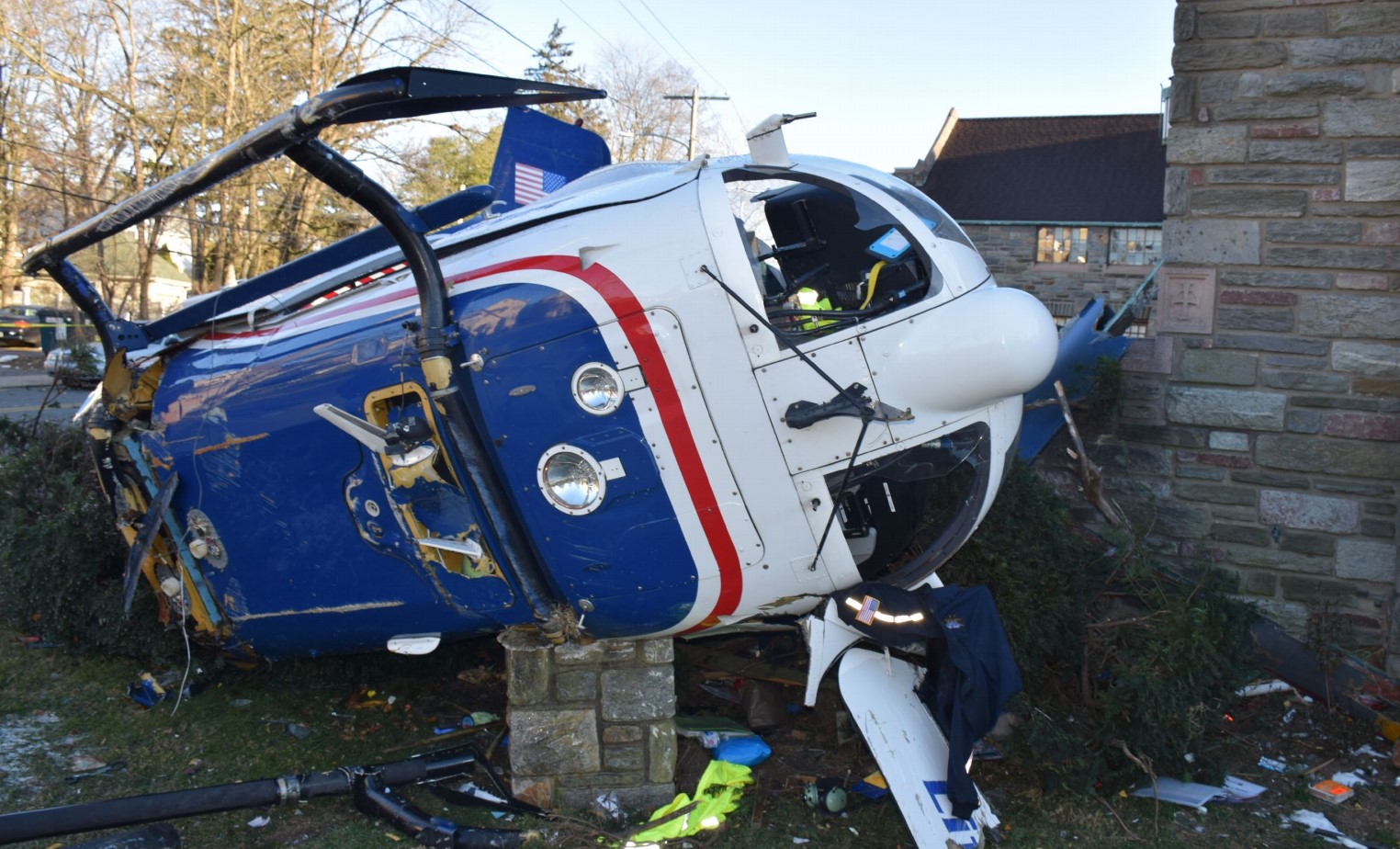
Wreckage of Air Methods Airbus EC135P2+ Air Ambulance N531LN (Credit: UDPD via NTSB)
The US National Transportation Safety Board (NTSB) issued their safety investigation report on 4 January 2024.
The Accident Flight
The helicopter departed Chambersburg Hospital about 12:05 Local Time, destined for Children’s Hospital of Philadelphia. The helicopter established itself in cruise at an altitude of c 3,500 ft before descending as they approached Philadelphia.
At 12:53:11, Automatic Dependent Surveillance – Broadcast (ADS-B) data revealed “a series of heading and altitude excursions” before the data was lost 6 seconds later.
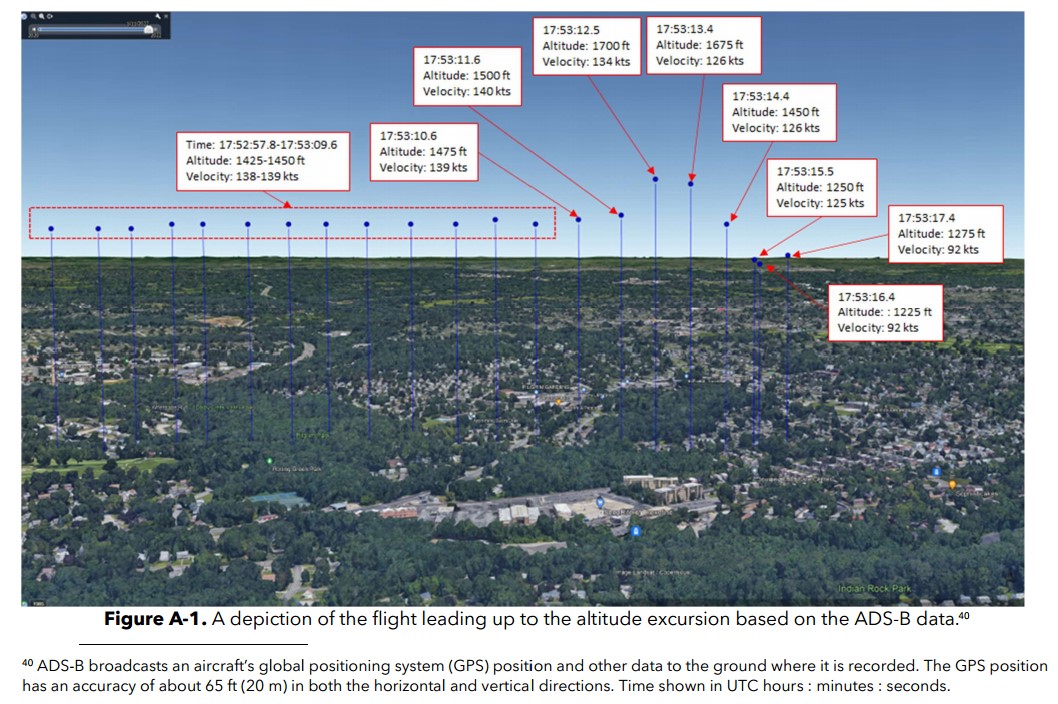 Doorbell cam recordings on the ground captured a “high-pitched whine…volume and pitch”.
Doorbell cam recordings on the ground captured a “high-pitched whine…volume and pitch”.
The NTSB report that:
Surveillance video showed the helicopter in a near-vertical, nose-down, spiralling descent.
The medical crew reported that the helicopter rolled inverted. No other evidence supported that. They however did manage to secure the patient and brace for impact.
The injured pilot, who had 4,123 total hours, 185 on type) had no memory of the initiating event and limited recollection of the final seconds of the flight. However the NTSB established that the pilot….
…arrested the rotation and recovered the helicopter from the dive but was unable to climb or hover due to insufficient engine power, thereby resulting in a hard landing…
The helicopter impacted the ground upright and came to rest on its left side adjacent to a church building.

Accident Site: Air Methods Airbus EC135P2+ Air Ambulance N531LN (Credit: AMC via NTSB)
All wreckage was found in a compact area with no substantial debris trail.
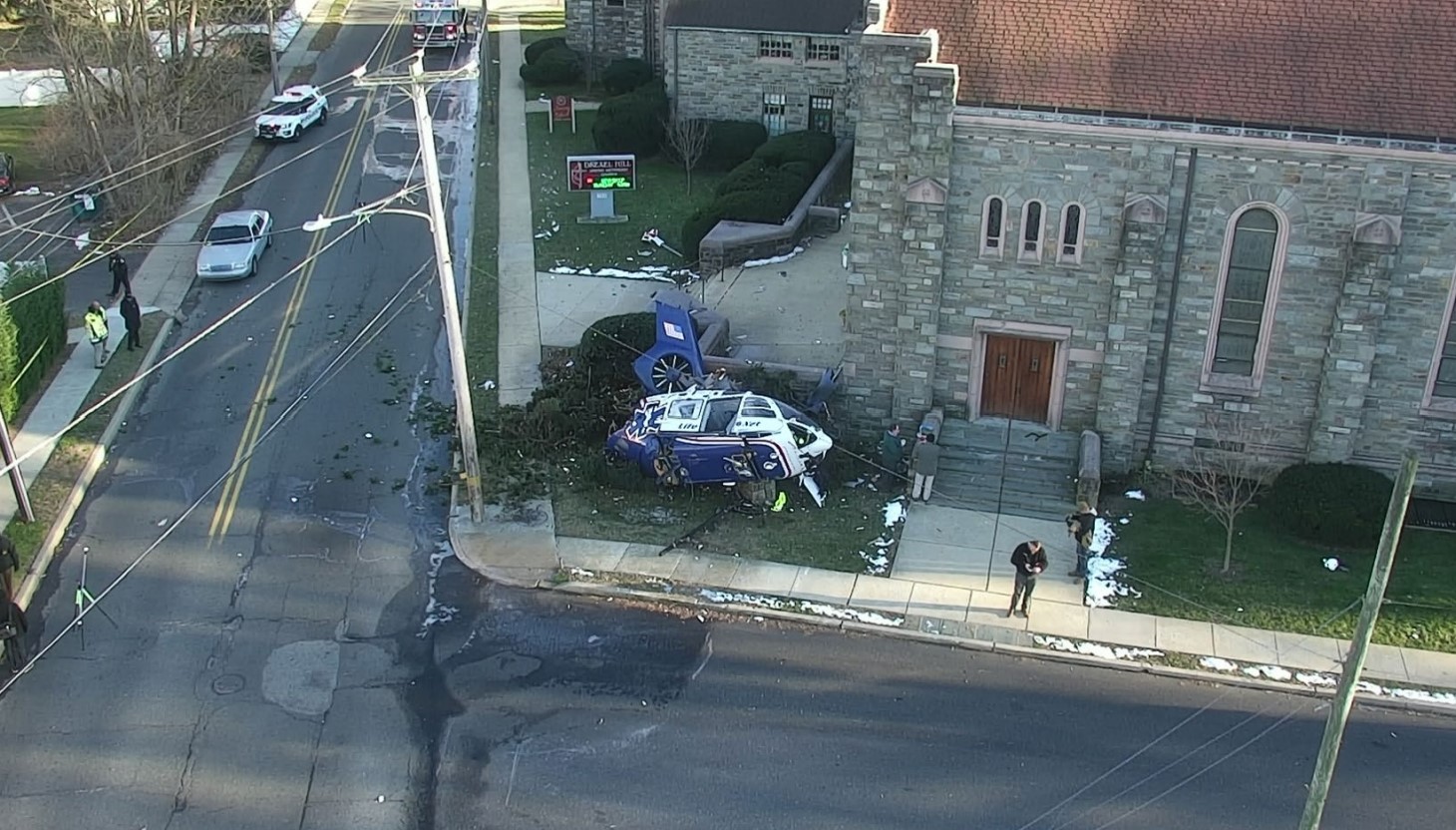
Accident Site: Air Methods Airbus EC135P2+ Air Ambulance N531LN (Credit: UDPD via NTSB)
The main fuselage was whole but… the airframe was partially separated on the upper side of the frame between the cockpit and cabin. All occupant seats remained installed within the cockpit and cabin. The aft-left seat was partially bent in a downward direction near the front edge of the seat.
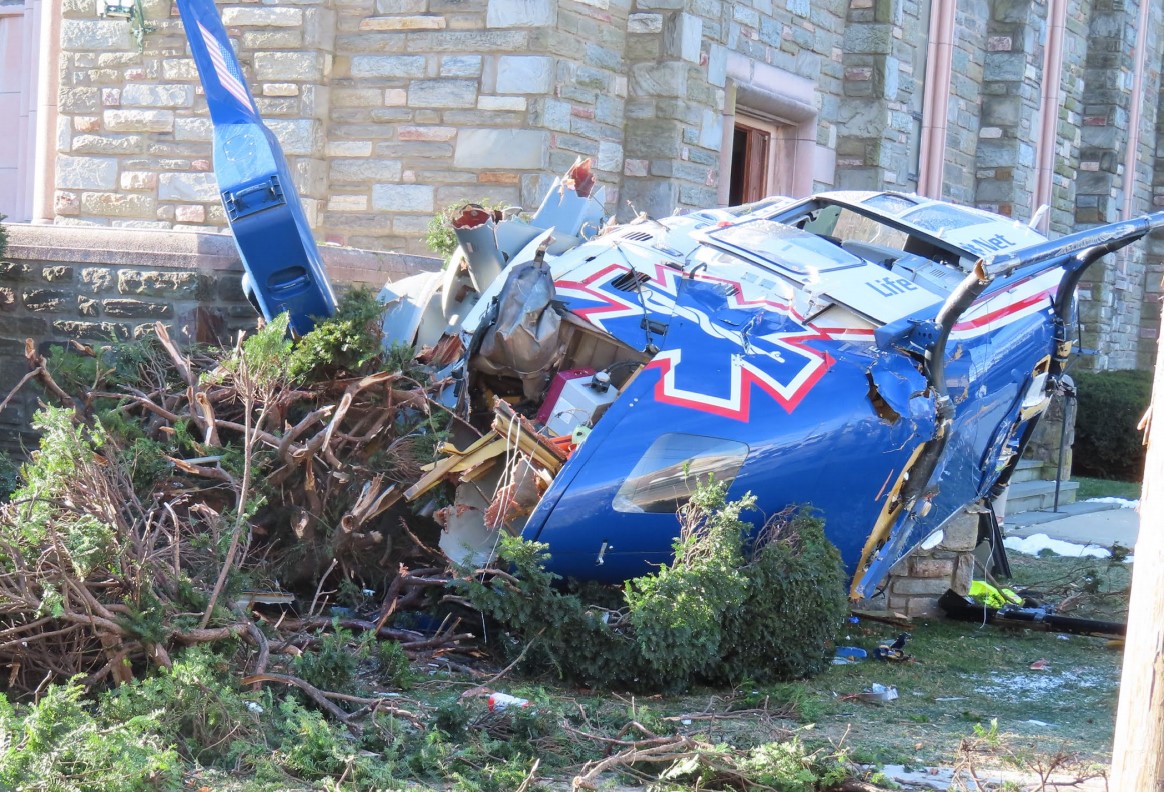
Wreckage of Air Methods Airbus EC135P2+ Air Ambulance N531LN (Credit: UDPD via NTSB)
Although not remarked upon by NTSB, it came to rest partly on a low wall.
The pilot was extracted from underneath. The medical personnel egressed through the right cabin door, carrying the patient.
NTSB Analysis
The accident helicopter, manufactured in 2006, was not equipped with, nor perhaps surprisingly “was it required to be equipped with, a flight data recorder (FDR), a cockpit voice recorder (CVR), or any flight recorder system that records cockpit audio and image”. The FAA had changed Part 135 in 2017 so that helicopter air ambulance operators had to comply with a Flight Data Monitoring (FDM) System requirement, FAR 135.607:
After April 23, 2018, no person may operate a helicopter in air ambulance operations unless it is equipped with an approved flight data monitoring system capable of recording flight performance data.
Its not clear in the NTSB report how AMC were achieving that regulatory requirement.
The NTSB investigators concluded that:
Examination of the helicopter revealed no evidence of malfunction that would result in an abrupt departure from cruise flight.
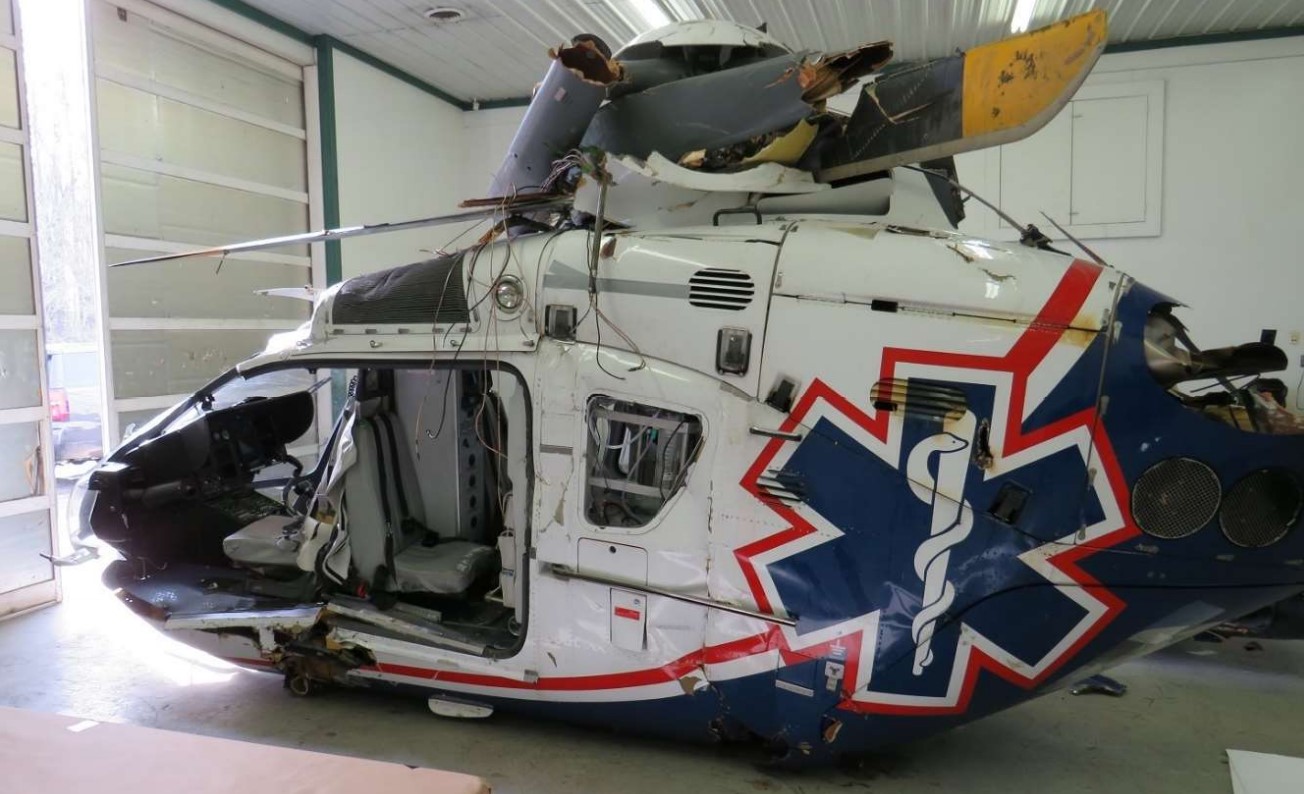
Wreckage of Air Methods Airbus EC135P2+ Air Ambulance N531LN (Credit: AMC via NTSB)
The investigators also note that:
The accident helicopter was equipped an AFCS [Automatic Flight Control System] composed of a SAS [Stability Augmentation System] and autopilot systems that can control helicopter pitch, roll, and yaw through various actuators.
The AFCS does not have any control authority for the collective control system.
They observe that:
Because of the limited control authority of the Stability Augmentation System (SAS) actuators [about 12% in the pitch axis, 14% in the roll axis, and 18.5% in the yaw axis] it is unlikely that a malfunction of a SAS actuator would have resulted in an inflight upset before the pilot could react to the malfunction.
Additionally, a malfunction of a trim actuator would not result in an inflight upset as the pilot would notice an attitude deviation before the trim actuator, whose rate of movement is limited by design, would be able to move the helicopter into an unusual attitude.
Lastly, the cyclic-mounted SAS/AP CUT button, which is inset to prevent unintended activation, will immediately disengage all AFCS functions, resulting in an unstabilized helicopter necessitating constant control inputs by the pilot to maintain attitude.
NTSB used a EC135P2+ flight simulator to determine the helicopter’s response to…
…various scenarios involving abrupt disconnection of the AFCS during high-speed cruise flight without hands on the flight controls. These scenarios included disconnection of the autopilot, specifically the altitude hold and heading hold upper modes, as well as disconnection of the entirety of the AFCS, including all stabilization systems, using the “SAS/AP CUT” button on the cyclic grip.
Significantly:
In all scenarios except those involving the SAS/AP CUT button, the helicopter remained stabilized. In scenarios involving the SAS/AP CUT button, the helicopter became unstabilized and required high pilot workload to regain control of the helicopter.
When a dual engine control failure was introduced to these scenarios involving disconnection of the AFCS, the pilot workload to land the helicopter increased. The most difficult scenario for the simulator pilot involved a dual engine control failure coupled with a complete disconnection of the entirety of the AFCS using the SAS/AP CUT button.
Previous Occurrence
On 28 November 2011 EC135 P2+ YR-CPC, was involved in an inflight upset near Niculești, Romania. The Romanian Civil Aviation Safety Investigation Commission (CIAS) investigated this serious incident. That helicopter was also not equipped with a FDR or a CVR.
According to the pilot of the occurrence, during cruise flight at an altitude of 3,000 feet and speed of 120 knots, the helicopter had a sudden and violent yaw to the right, followed by a nose down dive with a right roll. The pilot recalled the altitude hold and heading hold modes of the autopilot were active prior to the inflight upset, he was flying with his hand on the cyclic control due to reported turbulence in the area, and had no unusual cockpit indications prior to the inflight upset. During the inflight upset, the pilot stated he disconnected the autopilot upper modes and regained control of the flight after an altitude loss of about 1,500-2,000 feet. After the pilot stabilized the helicopter, he noted the CAD displayed “YAW SAS” and “ACTUATION”.
The investigation found that, due to the inflight upset, both engines simultaneously had a Nf overspeed of 116-117% and overtorque of 127%. Additionally, there was a NR overspeed in excess of 130% and a maximum mast moment value of 103.3%. The investigation examined and found no functional anomalies with the SEMAs, TRA, Fenestron control cable, and collective control friction. Ultimately, the initiating cause for the inflight upset could not be determined.
NTSB Conclusions
NTSB concluded that:
Data indicated that a main rotor system overspeed, which likely occurred during the dive maneuver, resulted in the overspeed of both engine power turbines [a peak of 126.79% Nf at near zero torque was recorded] due to the sudden reduction in load from the main rotor.
As a result of the power turbine overspeed, both engine control systems, independent of each other, functioned as designed and reverted to manual mode while at a minimum fuel flow rate.
Both engines continued to run at low power without automatic governing, resulting in insufficient power to continue normal flight as the engine twist grips remained in the normal fly position for the duration of the flight.
NTSB Probable Cause
An inflight attitude upset for undetermined reasons that resulted in a rotor system overspeed, a reduction of power from both engines, and a subsequent hard landing.
Our Observations
The NTSB, undoubtedly hampered by the lack CVR, FDR or cockpit camera, did not choose to conclude that an activation of the SAS/AP CUT button was the triggering event of the loss of control, despite the flight simulation trial evidence.
The crashworthiness of modern helicopters is demonstrated by this accident. Unfortunately the NTSB barely consider survivability matters.
As common for helicopter accidents the NTSB have no safety recommendations.
UPDATE 11 April 2024: video by The Doctor Medic
Safety Resources
The European Safety Promotion Network Rotorcraft (ESPN-R) has a helicopter safety discussion group on LinkedIn. You may also find these Aerossurance articles of interest:
- Police Helicopter Unanticipated Yaw & Fatal Water Impact
- EC135 Air Ambulance CFIT when Pilot Distracted Correcting Tech Log Errors
- Managing Interruptions: HEMS Call-Out During Engine Rinse
- Crashworthiness and a Fiery Frisco US HEMS Accident
- EC135P2 Spatial Disorientation Accident
- SAR AW139 LOC-I During Positioning Flight
- Firefighting AW139 Loss of Control and Tree Impact
- Distracted Dynamic Rollover
- EC135P2+ Loss of NR Control During N2 Adjustment Flight
- AAIB Report on Glasgow Police EC135T2+ Clutha Helicopter Accident
- HESLO EC135 LOC-I & Water Impact: Hook Confusion after Personnel Change
- EC135 Main Rotor Actuator Tie-Bar Failure
- Loss of Control, Twice, by Offshore Helicopter off Nova Scotia
- SAR Helicopter Loss of Control at Night: ATSB Report
- Fatal Night-time UK AW139 Accident Highlights Business Aviation Safety Lessons
- Automation Issues During Night SAR Training – Near CFIT
- Offshore Night Near Miss: Marine Pilot Transfer Unintended Descent
- North Sea Helicopter Struck Sea After Loss of Control on Approach During Night Shuttling (S-76A G-BHYB 1983)
- HEMS S-76C+ Night Approach LOC-I Incident
- NTSB Investigation into AW139 Bahamas Night Take Off Accident
- Night Offshore Training AS365N3 Accident in India 2015
- ‘Procedural Drift’: Lynx CFIT in Afghanistan
- Italian HEMS AW139 Inadvertent IMC Accident
- HEMS AW109S Collided With Radio Mast During Night Flight
- Night Offshore Windfarm HEMS Winch Training CFIT (BK117C1 D-HDRJ)
- Air Ambulance B407 Hospital Helipad Deck Edge Tail Strike During Shallow Approach
- US Air Ambulance Helicopter Hospital Heliport Tail Strike
- Air Methods AS350B3 Air Ambulance Tucson Tail Strike
- NTSB on LA A109S Rooftop Hospital Helipad Landing Accident

Recent Comments